Top News
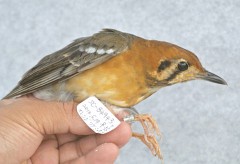
May 29, 2014 Tetsuya Nakajima, correspondent of Ryukyu Shimpo
On May 19 at Shinri beach in Kumejima Town, bird research duo Hatsuko and Kazunori Maehara spotted a female orange-headed thrush – a rare species in Japan. The married couple from Chiba prefecture visited the island for bird-banding as part of research by the Sankai Bird Resarch Institute sponsored by the Ministry of Environment.
After capturing the bird and banding its leg, they released it for biological research, including investigation of its range of action. There have been few observation records about the orange-headed thrush in Japan. According to a specialist, this is the first time researchers have released a marked orange-headed thrush in Japan.
The orange-headed thrush inhabits the area of southern China and India. Its head is orange and its wings and tail are light gray. Female birds have white dots on their wings. Previously, there was only one record of the bird, which was photographed in Tokara Island of Kagoshima Prefecture. This research confirmed the orange-headed thrush flies to Kumejima Island.
(English translation by T&CT and Megumi Chibana)
Go to Japanese
May 26, 2014 Ryota Shimabukuro of Ryukyu Shimpo reports from Washington D.C.
In a conference held in Washington D.C., U.S. Navy Admiral Jonathan Greenert stated the U.S. military plans to station unmanned aerial surveillance aircraft Northrop Grumman MQ-4C Triton in Okinawa from 2017.
The MQ-4C Triton is an unmanned aerial surveillance aircraft that builds on an earlier model, the Northrop Grumman RQ-4 Global Hawk.
The U.S. military plans to station the aircraft at Kadena Air Base.
This will be the first time the U.S. military has station an unmanned aerial vehicle (UAV) in Okinawa.
Greenert explained that stationing the aircraft in Okinawa was a part of the U.S. Rebalancing strategy for the Asia-Pacific region. As part of this strategy, the U.S. military is reinforcing military bases in Okinawa.
The U.S. military stationed six Boeing P-8 Poseidon of the U.S. Navy at Kadena Air Base last year.
Triton is designed to operate with P-8 Poseidon.
The U.S. military temporarily stationed the Global Hawk at Misawa Air Base in Aomori Prefecture. The Japanese government plans to purchase MQ-4C Triton aircraft for the Self-Defense Forces.
Greenert also stated the U.S. military would station the Lockheed Martin F-35 Lightning II in the western Pacific in the late 2010s. However, he did not refer to the specific countries, regions or military bases to which they will be stationed.
(English translation by T&CT)
Go to Japanese
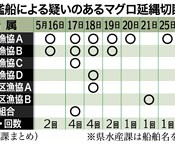
May 29, 2014 Ryukyu Shimpo
In waters about 110 kilometers southwest of the main Island of Okinawa, seven tuna fishing boats had their trawl lines cut off by an unknown party.
The Okinawa Prefectural Government (OPG) reported that 15 incidents had occurred from May 16 to 25. The boats, which are part of the Okinawa Tuna Fishery Association that has fishing rights in the Adjacent Sea, had their trawl lines cut off six times. There is a suspicion U.S. navy warships were involved. The government has asked the U.S. military what happened, but had not received a response as of May 28.
In particular, on May 17 and 18, six boats belonging to the association, Naha Fishery Association and Boat Owners Association of Okinawa had their lines cut off eight times.
A crew member from one of the targeted ships said, “We had difficulty fishing because of having several parts of the lines cut. Although we halted fishing, and started looked for the lost fishing gears, by the end of the afternoon, we could not find them.” Another said, “The lines were worn and cut. With rust on the cut edge, they were scratched by wire.”
(English translation by T&CT)
Go to Japanese
May 23, 2014 Wu Li Jun of Ryukyu Shimpo
Tianjin Airlines, based in Tianjin, China, will operate its charter flights to Naha from June 1. Charter flights by Tianjin Airlines will run every Thursday and Sunday for one year.
Since September 2012, when the relationship between Japan and China began to worsen after the Japanese government nationalized the disputed Senkaku Islands, this is the first charter flight to Okinawa that the government of China has approved. It is also the airline’s first Japan route. It will use Airbus A320 with 174 seats for the flights.
Currently, there are two routes between Naha and airports in China – Shanghai and Beijing. These are run by China Eastern Airlines, Juneyao Airlines, and Air China. Tianjin Airlines will open a third route to China, to Tianjin City.
Hainan Airlines suspended flights between Naha and Beijing in September 2012.
Yuji Taira, the director of the Beijing Office of the Okinawa Prefectural Government, said, “Because of the Senkaku Islands issue, the government of China has not been approving any new charter flights between China and Japan. Thus, this new charter flight between one of the national central cities and Japan has major implications for tourism.” Tianjin is a metropolis in northern China and one of the five national central cities of the People’s Republic of China.
(English translation by T&CT, Hitomi Shinzato)
Go to Japanese
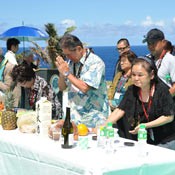
May 28, 2014 Hisao Tome reports from Tinian
The 37th memorial service for the Okinawan war dead was held at the Tower of Okinawa in Tinian on May 27. About 100 people, including Okinawan returnees from Tenian, their families and local officials, attended the memorial service. They consoled the spirits of people who died in the war 70 years ago. The Tower of Okinawa is located at the so-called “suicide cliff” on the east coast of the southern part of the island. Many civilian people and soldiers of the Imperial Japanese Army, who had been cornered by the U.S. military, jumped into the sea from the top of the cliff.
“We cannot forget the tragic scene in which many Okinawan people died. We will not forget our brethren who sleep beneath the land of this island forever,” Asami Ginoza, the chairman of the Okinawa Tinian Association said. “We will continue to visit Tinian to see their spirits in front of this monument.”
Zenki Isa, 78, lost seven family members in Tinian. “It was a terrible situation, as if we were plunged into hell, when I lost my family members. It was a distressing event that I hated to recall,” he said in his speech on behalf of the bereaved families. He stressed, “We should fully realize the folly of war and the value of peace. We pray for their souls to rest in peace.”
(English translation by T&CT)
Go to Japanese
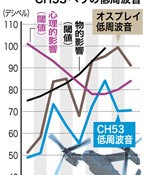
May 27, 2014 Ryukyu Shimpo
Takeshi Tokashiki, an associate professor at the University of the Ryukyus, has surveyed the frequency of noise emitted by the MV-22 Osprey and CH-53 helicopters stationed at the U.S. Marine Corps Futenma Air Station. The survey revealed the Osprey aircraft’s noise was louder than the CH-53 by about 30 decibels.
This is the first time researchers have carried out a survey on the noise frequency of both aircraft under the same weather and time conditions.
According to Tokashiki, the 30 decibel difference between the Osprey and the CH-53 translates to about eight times the noise level to the human ear.
Tokashiki carried out the survey on the roof of the Second Futenma Elementary School in Ginowan on May 16.
He surveyed low-frequency noises emitted by the Osprey at 9:16 a.m. and the CH-53 helicopter at 9:28 a.m. when both the aircraft took off. At 63 hertz, the noise of the Osprey was 99.4 decibels, and that of the CH-53 helicopter was 70.2.
Low-frequency noise is sound that is lower in frequency than 100 hertz. It can cause headaches or sickness and shake fittings.
The survey detected noise higher than the threshold level stipulated in the environmental assessment report created by the Okinawa Defense Bureau for the Henoko relocation. Tokashiki asserted, “We confirmed the low-frequency noise from the Osprey by comparing with the CH-53 helicopter.” Referring to the fact the assessment report did not survey the low-frequency noise from the Osprey, he stressed the importance of carrying out a precise survey on the noise.
(English translation by T&CT)
Go to Japanese

May 26, 2014 Ryukyu Shimpo
Okinawa’s national league basketball team won the championship in Japan’s professional basketball league or “bj league” at Ariake Colosseum in Tokyo on May 25. In the play off for the 2013-2014 season championship, the Ryukyu Golden Kings beat the Akita Northern Happinets of Akita Prefecture, 103 to 89. It is the third time the Kings have won the championship.
The Kings held a press conference to announce their victory at the Okinawa Prefectural Government Office building on May 26.
A representative of the team Tatsuo Kimura said, “Even though it was a long season, we were able to win the championship thanks to the support from Okinawan people.”
A first-year head coach of the team Tsutomu Isa said, “It was a great season because we stood together as a team to win, which was a theme of this season.”
The team captain Shigeyuki Kinjo said, “I am glad that we exerted ourselves to the utmost in the final.”
Ryuichi Kishimoto who earned the finals Most Valuable Player, said, “I was fortunate to be in good shape in the final.”
On the same day, the team held a party to announce its victory to Okinawan citizens at the OPG building. Many people came to celebrate the team’s accomplishment. Okinawan Vice Governor Kurayoshi Takara said, “The Kings gave courage and hope to Okinawan people. I would like the team to continue to thrill us.”
(English translation by T&CT)
Go to Japanese
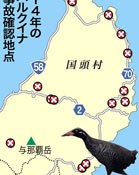
May 21, 2014 Ryota Uehara of Ryukyu Shimpo
Seven Okinawan rails were hit and killed by cars in non-risk zones this month. The number is more than the total killed from January to April. While most accidents occur in areas where rails are known to roam and signage warns drivers to look out for them, all the accidents in May happened in non-risk areas.
A nature ranger at the Center Ichihito Yamamoto said, “There is a possibility the habitat density of Okinawan rails is increasing.”
From January to April, six accidents occurred, with one bird surviving, according to the Ministry of the Environment’s Yambaru Wildlife Conservation Center. In May, there were seven accidents, with no bird surviving. Of these accidents, not one occurred in the areas marked for accident prevention.
Route 70 and Route 2 on the east coast, and in the mountain area of Kunigami Village, are designated as part of a zone where accidents are most likely to happen. There are warning signs in an area covering 1.8 kilometers on route 70, in Sosu, Kunigami, where many accidents have occurred in recent years. However, this year, there have been no cases at this zone. Instead, accidents happened in the districts of Hiji and Aha, which are bordering on Ogimi Village and Higashi Village respectively.
Kunigami, Higashi, and Ogimi villages, and various national conservation bodies recently discussed setting up more warning signs at a “Yanbaru Road Kill Prevention Liaison Conference” held in April.
Accidents during the breeding season from April to June often leave baby birds stranded without a mother, leading to their starvation.
Yamamoto said, “We would like to avoid any accidents this season. People need to be aware that Okinawan rails inhabit Ogimi and Higashi. ”
(English translation by T&CT and Megumi Chibana)
Go to Japanese
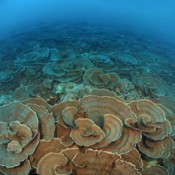
May 26, 2014 Ryukyu Shimpo
Large coral reefs were found on the deep-ocean floor off Nagura Bay, Ishigaki Island and off Iriomote Island. The reefs are at a depth of 30-55 meters. At a meeting of the 51st Okinawa Biological Society held at the University of the Ryukyus, Nishihara, on May 25, Toru Naruse, a researcher at the Tropical Biosphere Research Center of the University of the Ryukyus announced this report.
According to the researcher, there are large coral reefs at eight locations around Iriomote Island, including six in Funauki Bay, one off coast of Akasaki and one off coast of Ballast, and two locations off Nagura Bay, Ishigaki. The coral reefs off Funauki Bay in Iriomote Island are the largest ones discovered. The reefs are about 540 meters in length and 150 meters in width. They are mainly covered with large numbers of pachyseris speciosa .

The locations of large coral reefs discovered this time.
Coral reefs are found commonly in shallow water, where direct sunlight allows photosynthesis to occur easily. It is uncommon for coral reefs to grow at medium sea-depth. The ecosystems of the deep-sea reefs are not yet fully understood by scientists. Naruse said, “We need to continue the investigation.”
(English translation by T&CT)
Go to Japanese
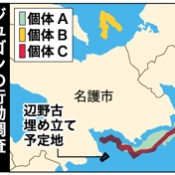
May 23, 2014 Ryukyu Shimpo
The Okinawa Defense Bureau released a research report on the living organisms in the waters around Camp Schwab, on May 22. The research was carried out from November 2012 to March 2013. The defense bureau is proceeding with building a new base to replace Marine Corps Air Station Futenma in Henoko, Nago. The defense bureau has now announced a key finding from the 2013 survey; traces of dugongs eating seaweed and seagrass beds on the Oura Bay side of Henokozaki, the proposed the landfill site. Seaweeds, such as eelgrass, which dugongs feed on, abound in the area, according to the research. The defense bureau saw 17 dugongs over 15 days in Kayo, Oura Bay and the sea near Kouri Island.
Meanwhile, volunteer research group “Zan” found more than 30 traces of seagrass eaten by dugongs on the Oura Bay side of Henokozaki by May 21. Some experts stress that the planned site for landfill is likely to be an important feeding ground for dugongs. The survey data suggests that the habitat of the dugong covers a wide range of areas from the east side of the northern part of the main island to the west coast. Environmental protection groups are concerned that the landfill construction will affect the dugongs because the proposed area for dredging sand and transporting it for landfill is part of their habitat.
According to the research report , the number of dugongs there is three, a male, female, and their child.
Taro Hosokawa, the deputy secretariat of the Okinawa Dugong Network, said, “The dugongs found in Kouri Island in the past have moved to Oura Bay, and they might live in the east coast. He pointed out that Oura Bay of Henokozaki has possibly become one of a few feeding grounds of the dugongs. He doubts that only three dugongs live there. He said, “It is difficult to identify individuals other than the dugong that has the split tail fin.”
The defense bureau started the environmental investigation at the planned site in 2009. It has now released the report in its website.
(English translation by T&CT)
Go to Japanese
May 23, 2014 Ryukyu Shimpo
On May 22, the Okinawa Defense Bureau signed an agreement with the Nago Fisher’s Union. The bureau will pay about 3.6 billion yen in compensation for reclaiming the sea around Henoko in Nago for the relocation of U.S. Marine Corps Air Station Futenma. Hirofumi Takeda, chief of the bureau, announced the agreement at a press conference held on May 22, saying, “I will not go into details.”
The union voiced strong disagreement at an initial offer of 2.4 billion yen, and settled on an agreement after a 50 percent increase in the offer. Accepting the agreement, the government will begin marine boring investigations in July in preparation for the reclamation.
The union held a directors’ meeting on May 22. There were discussions on sharing the money from the compensation and every union member will be given about 20 million yen. However, no announcement was made on the total sum received in compensation. The union will provide details for union members at a special general meeting on May 30.
According to a spokesperson for the bureau, they signed the agreement on May 20. The bureau calculated the compensation sum based on the country’s loss compensation standards. They then increased it on the assumption the union will lose fishing profits rights because of the reclamation and future construction work negatively affecting the fishing industry. The bureau will pay about 90 of the union members and 30 associate members by June.
The bureau sought agreement from the union for the reclamation last February. The union filed the approval papers to the bureau in March of the same year.
(English translation by T&CT and Lima Tokumori)
Go to Japanese









 Webcam(Kokusai Street)
Webcam(Kokusai Street)


